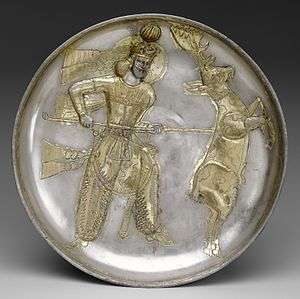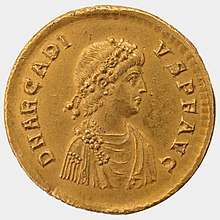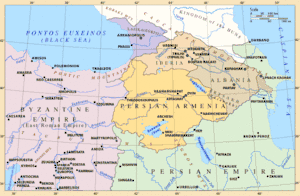Yazdegerd I
| Yazdegerd I 𐭩𐭦𐭣𐭪𐭥𐭲𐭩 | |
|---|---|
|
"King of kings of Iran and Aniran" (Middle Persian: Sāhānšāh Ērān ud Anērān) | |
 5th-century plate of Yazdegerd I slaying a stag | |
| Shahanshah of the Sasanian Empire | |
| Reign | 399 – 21 January, 420 |
| Predecessor | Bahram IV |
| Successor | Shapur IV |
| Died |
21 January, 420 Gurgan, Iran |
| Consort | Shushandukht |
| Issue |
Shapur IV Bahram V Narseh |
| House | House of Sasan |
| Father | Shapur III |
| Religion | Zoroastrianism |
Yazdegerd I (Middle Persian: 𐭩𐭦𐭣𐭪𐭥𐭲𐭩 <yzdkrt|> Yazdekert, meaning "made by God"; New Persian: یزدگرد Yazdegerd) was the twelfth king (shah) of the Sasanian Empire. He was the son of Shapur III (383–388).[1] He succeeded on the assassination of his brother Bahram IV in 399 and ruled for twenty-one years till his death in 420.
Yazdegerd I's reign was largely uneventful. The shah is described as being of a peaceful disposition. There were cordial relations between Persia and the Eastern Roman Empire as well as between Persia and the Western Roman Empire. Early during his reign, Yazdegerd was entrusted the care of the Roman prince Theodosius by his father Arcadius on the latter's death in 408, and Yazdegerd faithfully defended the life, power and possessions of the Roman prince.[2]
Yazdegerd promoted Christianity in the early years of his reign and later opposed it. He is known in Sasanian sources (and also in Islamic Persian sources who use Sasanian sources as their references) as "the Sinner". However, this was propaganda made by the Zoroastrian aristocrats and priests due to his persecution of them due to their opposition towards him, and his tolerance towards his non-Zoroastrian subjects, such as the Christians and the Jews.[3][4] Yazdegerd also used the title of "Ramshahr" ("who maintains peace in his dominion"), which fitted to him, due to his peace with the Romans and tolerance towards his subjects. The title "Ramshahr" was a title used by the legendary Kayanid kings, and thus starts the Sasanian interest in Kayanid history, where they later would adopt the title of "Kay" and use the slogan "xwarrah".[4] However, due to the Christians' use of his tolerance to attack the Zoroastrians, the appointment of the intolerant vizier Mihr Narseh, resulted in persecutions of the Christians,[3] and also the struggle to convert Armenia to Zoroastrianism.
Since the death of the powerful Sasanian shah Shapur II (r. 309–379), the aristocrats and priests had expanded their influence and authority at the cost of the Sasanian government, nominating, dethroning, and murdering shahs, which included Yazdegerd, who was murdered in 21 January 420. They then sought to stop the sons of Yazdegerd from the ascending the throne—Shapur IV, who was the eldest son of Yazdegerd and governor of Armenia, quickly rushed to the Sasanian capital of Ctesiphon, and ascended the throne. He was, however, shortly murdered by the nobles and priests, who elected a son of Bahram IV, Khosrow, as shah.[5] Another son of Yazdegerd, Bahram V hurried to the Sasanian capital of Ctesiphon with an Lakhmid army, and won the favour of the nobles and priests, according to a long-existing popular legend, after withstanding a trial against two lions.
Etymology
The name of Yazdegerd is a combination of the Old Iranian yazad yazata- "divine being" and -karta "made", and thus stands for "God-made", comparable to Iranian Bagkart and Greek Theoktistos. The name of Narseh is known in other languages as; Pahlavi Yazdekert; Syriac Yazdegerd, Izdegerd, and Yazdeger; Talmudic Izdeger and Azger; Arabic Yazdeijerd; Greek Isdigerdes.[3]
Reign
Yazdegerd was the son of Shapur III (383–388). Yazdegerd had three sons whom were named: Shapur IV, Narseh, and Bahram V. When Yazdegerd's brother Bahram IV was assassinated in 399, he succeeded him.[6] The Persian soldiers who had murdered Bahram IV did not hurt him on account of his excellent character and fine disposition. The general tenor of his rule was quite peaceful.
Relations with Rome
The Ostrogoth invasion of 386, the revolt of Maximus in 387, the Antioch revolt of 387, the invasion of Gaul in 388, the massacres at Thessalonika and the rebellion of Arbogastes and Eugenius in 393 had severely weakened the Roman Empire. Between 386 and 398, Gildo the Moor ruled an independent kingdom in Africa, and in 395 the Goths took to arms under their leader Alaric.[7] But Yazdegerd on his accession to the throne desisted from assuming any aggressive posture towards the Eastern Roman Emperor Arcadius or the Western Roman Emperor Honorius. Yazdegerd's extreme tranquility and his reluctance to invade the Roman Empire earned him the epithet "Ramashtras," "the most quiet," or "the most firm," he justified his assumption of it by a complete abstinence from all military expeditions.[8]
Adoption of Theodosius

On the ninth year of his reign, it is believed, Yazdegerd was entrusted the care of Prince Theodosius by his father Arcadius, the Eastern Roman Emperor.[8] It was strange that Arcadius chose neither his younger-brother Honorius nor any of his distinguished subjects for the purpose and instead entrusted his son to the charge of the Persian monarch. He accompanied the appointment by a solemn appeal to the magnanimity of Isdigerd, whom he exhorted at some length to defend with all his force, and guide with his best wisdom, the young king and his kingdom. One writer even goes to the extent of claiming that Arcadius gifted Yazdegerd a thousand pounds of pure gold in return for his favour. When Arcadius died, and the testament was opened, information of its contents was sent to Isdigerd, who at once accepted the charge assigned to him, and addressed a letter to the Senate of Constantinople, in which he declared his determination to punish any attempt against his ward with the extremest severity. Flattered, he performed his newfound role with utmost sincerity providing him the best possible education and assistance.
A eunuch named Antiochus was selected and sent to Constantinople to look after the young Emperor.[9] He was, for many years, the prince's intimate companion. He was supposed to have been killed or expelled from the kingdom by Pulcheria, elder sister of Theodosius. However, even after Antiochus' end, Yazdegerd continued his aid to the young monarch.[9]
Procopius has praised the "display of virtue" by Yazdegerd in his treatment of Theodosius.[10]
However, these narratives were written a century and a half after the death of Arcadius, and have been rejected by modern scholars due to the silence of contemporary writers as outweighing the positive statements of the later ones.
Religious policy
According to Wein, Yazdegerd I was a wise, benevolent, and astute ruler.[11] He was also known for his religious tolerance, towards both Christians and Jews. For example, the Talmud (Ksubos, 61a) relates that Ameimar, Rav Ashi, and Mar Zutra would sit in his court. However, excessive zeal of the Christian bishop of Ctesiphon, Abdaas, provoked a reaction, and when he tried to burn the Great Fire temple of Ctesiphon, Yazdegerd I turned against the Christians (see following).
Inclination towards Christianity
During the early part of his reign, Yazdegerd inclined towards Christianity. George Rawlinson feels that Yazdegerd may even himself wanted to convert to Christianity.[12] Antiochus openly wrote in favor of Christians, and this rapidly increased conversions to Christianity.[12] Yazdegerd also persecuted the Magi, the Zoroastrian high-priests, who opposed him and his ideas.
Yazdegerd is believed to have been an ardent follower of at least two prominent Christian bishops: Marutha, bishop of Mesopotamia, and Abdaas, the bishop of Ctesiphon.[12] Marutha in particular exerted a great amount of influence over the shah, and it was at his insistence that Yazdegerd issued a declaration in 410 giving Christians the freedom of worship.[13] This proclamation is sometimes regarded as "the Edict of Milan for the Assyrian Church".[14] Furthermore, in order to create a religious buffer between the Church of Rome and the Persian Church, Yazdegerd actively promoted Christianity.[15]
According to the Byzantine historian Procopius, "From the start, Yazdegerd was a sovereign whose nobility of character had won for him the greatest renown. He gave his Christian subjects such freedom, even support that they prayed daily for the safety of 'the victorious and glorious king' ".[16] A contemporary Christian account says that "the good and clement King Yazdegerd did well to the poor and wretched".[17][18]
Yazdegerd sent the Catholicos of Seleucia-Ctesiphon to mediate between the shah and his brother who governed Pars. Another Catholicos was Yazdegerd's envoy to Theodosius.
Dispute with Abdas
Engaged in a dispute with the local magi in AD 420, Abdas was accused of burning down one of their temples, a pyramid of Ahura Mazda. Yazdegerd ordered the bishop to restore and repair the building at his own expense, upon Abdas' refusal the shah ordered the destruction of the churches.[19] During the same period, Mihr Narseh was appointed as Yazdegerd's wuzurg framadār (vizier or prime minister), who managed to change the peaceful policy of Yazdegerd, and which resulted in persecutions of Christians.[20]
Relations with Armenia

When indulging in the persecution of Christians in Persia, Mihr Narseh also attempted to spread Zoroastrianism in Armenia. Under these circumstances, Isaac, the Metropolitan of Armenia, proceeded to the court of Ctesiphon, and petitioned Yazdegerd to replace Artaxias IV with Khosrov IV who had been deposed twenty-one years earlier, and whom Bahram IV had imprisoned in the "Castle of Oblivion".[21] Yazdegerd I released Khosrov IV and reinstated him upon the throne of Armenia in order to stabilize the condition. However, Khosrov IV survived for only a year, and on his death, the throne became empty once again, leaving Armenia to chaos.[22] So Yazdegerd responded by placing his own son Shapur IV on the throne of Armenia, forcing him upon the reluctant nobles of Armenia.[22] Shapur IV concentrated on reconciliation and established friendly relations with the nobles. He ruled Armenia for four years and returned to Ctesiphon in 419 to capture the throne from the shah Yazdegerd I, who was in his death-bed.[22]
Death
Yazdegerd I died in 420. However, the circumstances surrounding Yazdegerd's death are not clear. According to a long-existing popular legend, he was killed during his stay in Gurgan by a fabulous horse which emerged magically from a stream. This happened near Tus according to Ferdowsi The legend may be some sort of an allusion to his death at the hands of his nobles.[23][20]
War of succession
When Yazdegerd I was overcome by mortal illness in the year 419,[22] Shapur IV immediately rushed to Ctesiphon to claim the Sassanian throne leaving behind a viceroy to govern Armenia.[22] But the viceroy-designate was killed soon after Shapur left Armenia. A battle of succession followed and lasted for three years after Yazdegerd's death.[22] Shapur was treacherously killed by the courtiers in the initial stages of the battle. Bahram V arrived from Al-Hira and captured the throne after defeating the Persian nobles with an Arab army in a three-year-long battle.[22] Narseh, another son of Yazdegerd I was appointed governor of Khorasan.
Coins of Yazdegerd I

The coins of Yazdegerd are not of much artistic value. They all bear the head of a middle-aged man, with a short beard and hair gathered behind the head in a cluster of curls. The distinguishing mark is the inflated ball above the headdress which is adorned with a crescent in the front. On the reverse side of the coin is a fire-altar. The coins bear the legend: "Mazdisn bag ramashtras Izdikerti, malkan malka Airan," or "the Ormazd-worshipping divine most peaceful Yazdegerd, king of the kings of Iran;" and on the reverse, Ramashtras Izdikerti, "the most peaceful Isdigerd".[22] In some cases, Yazdegerd's coins also bear the names of "Ardashatri" (Ardashir) or, "Varahran", probably a reference to Ardeshir, the founder of the Sasanian Empire and Yazdegerd I's son Bahram V or Bahramgur. Perhaps a more reasonable account of the matter would be that Yazdegerd had originally a son Ardeshir, whom he intended to make his successor, but that this son died or offended him, and that then he gave his place to Bahram Gur.
References
- ↑ Nöldeke 1879, p. 73 n. 3.
- ↑ This is, of course, not true: [Edward Gibbon; The History Of The Decline & Fall Of The Roman Empire; Womersley ed.; Ch.32, pg.261 (Vol.II)]
- 1 2 3 Shapur Shahbazi 2003.
- 1 2 Daryaee 2008, pp. 21-22.
- ↑ Klíma 1999, pp. 514-522.
- ↑ Shapur Shahbazi 2005, "Sasanian Dynasty"
- ↑ Rawlinson 1882, p.270.
- 1 2 Rawlinson 1882, p.272.
- 1 2 Rawlinson 1882, p.273.
- ↑ Christopher Lillington-Martin (6 July 2017). Procopius of Caesarea: Literary and Historical Interpretations. Taylor & Francis. p. 69. ISBN 978-1-317-07549-3.
- ↑ Wein
- 1 2 3 Rawlinson 1882, p.275.
- ↑ Asmussen, 1983, p. 940
- ↑ Wigram, p. 89
- ↑ Robert Bruce Mullin. A Short World History of Christianity. Westminster John Knox Press. pp. 82–85. ISBN 978-0-664-23664-9.
- ↑ Procopius(1.2, 8)
- ↑ Nöldeke 1879, p. 75 n..
- ↑ Greatrex-Lieu, p. 32
- ↑ Theodoret, v. 39
- 1 2 Daryaee 2008, p. 24.
- ↑ Rawlinson 1882, p.277.
- 1 2 3 4 5 6 7 8 Rawlinson 1882, p.278.
- ↑ Nöldeke 1879, Nöldeke, p. 77 and n. 1, p. 78.
Sources
- Shapur Shahbazi, A. (2005). "SASANIAN DYNASTY". Encyclopaedia Iranica, Online Edition. Retrieved 4 January 2014.
- Shapur Shahbazi, A. (2003). "YAZDEGERD I". Encyclopaedia Iranica.
- Daryaee, Touraj (2008). Sasanian Persia: The Rise and Fall of an Empire. I.B.Tauris. pp. 1–240. ISBN 0857716662.
- Pourshariati, Parvaneh (2008). Decline and Fall of the Sasanian Empire: The Sasanian-Parthian Confederacy and the Arab Conquest of Iran. London and New York: I.B. Tauris. ISBN 978-1-84511-645-3.
- Shapur Shahbazi, A. (2005). "SASANIAN DYNASTY". Encyclopaedia Iranica, Online Edition. Retrieved 30 March 2014.
- Rawlinson, George. (1882). The Seventh Great Oriental Monarchy. Dodd, Mead and Company
- Rawlinson, George. (1885). The Seven Great Monarchies of the Eastern World, Vol 7 . J. B. Alden
- Nöldeke, Theodor tr., ed. (1879), Geschichte der Perser aus Ṭabarī, Brill
- Herman, Geoffrey. The last years of Yazdgird I and the Christians. Jews, Christians and Zoroastrians: Religious Dynamics in a Sasanian Context. (Judaism in Context 17) Gorgias Press: Piscataway, 2014, pp. 67-90.
- Bosworth, C. E., ed. (1999). The History of al-Ṭabarī, Volume V: The Sāsānids, the Byzantines, the Lakhmids, and Yemen. Albany, New York: State University of New York Press. ISBN 978-0-7914-4355-2.
- Frye, Richard Nelson (1984). The History of Ancient Iran. C.H.Beck. pp. 1–411. ISBN 9783406093975.
- Kia, Mehrdad (2016). The Persian Empire: A Historical Encyclopedia [2 volumes]: A Historical Encyclopedia. ABC-CLIO. ISBN 978-1610693912.
Yazdegerd I | ||
| Preceded by Bahram IV |
Shahanshah of the Sasanian Empire 399–420 |
Succeeded by Shapur IV |